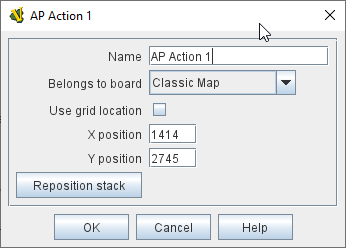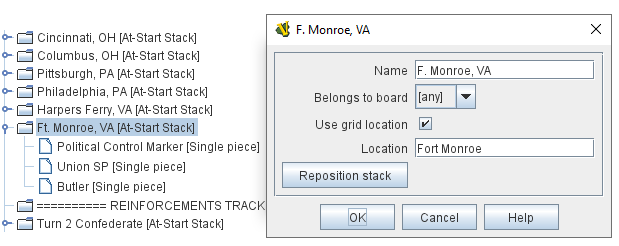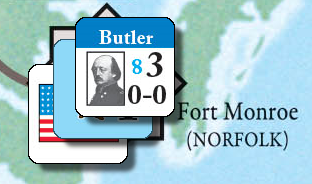VASSAL Reference Manual
At-Start Stack
An At-Start Stack is an ordinary stack of playing pieces that is initialized in a specified map location at the beginning of every game. It can be used to place pieces in their starting positions (particularly when the starting positions are true regardless of scenario). It is also appropriate for any fixed pool of counters. When the game begins, the pieces are in place just as if they had been dragged from the Game Piece Palette, except that no more can be created during the course of the game.
To add an At-Start Stack, navigate to the entry for your Map in the Editor, right-click on the [Map] component entry, and select Add At-Start Stack. Then, right-click on the [At-Start Stack] component entry created at the bottom of your Map’s list of sub-components, and select Add Single Piece to add a piece to the stack. You can add as many pieces as you wish to each At-Start Stack.
EXAMPLE: A strategic game in which a nationality has a fixed force pool of Infantry, Armor, etc. counters can be modeled by making a Map Window representing the force pool, with an At-Start Stack of Infantry counters, an At-Start Stack of Armor counters, etc. In order to guarantee that the number of each type of counter is fixed, the Clone and Delete functions of the Infantry and Armor counters should be disabled.
EXAMPLE (see illustration): A card-driven strategy game in which the Union player begins with a Political Control marker, a single SP or "strength point", and General Butler in Ft. Monroe, VA. An At-Start Stack is created and assigned to use the grid location of Ft. Monroe. Then, a Political Control single piece, a Union SP single piece, and a Butler single piece are added to the stack. As in real life, the first counter placed in a location goes "on the bottom" and each successive counter is placed above it. Thus, General Benjamin "Spoons" Butler will appear on top of his stack.
|
|
Sub-Components
Single Piece
An At-Start Stack can contain any number of Game Pieces. Right-click on the [At-Start Stack] component in the Editor and select Add Single Piece to add a piece to the At-Start Stack. You can then open the properties for the [Single Piece] to define it. Adding a Prototype trait reference is often the quickest and most efficient way to define pieces.


